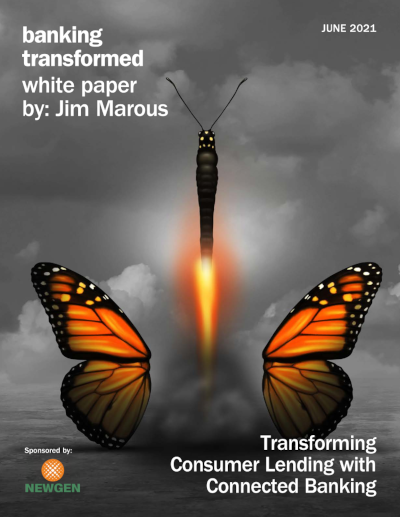Transforming Consumer Lending with Connected Banking
White Paper
Jim Marous
June 2021
: DBR 280
29 pages, 10 tables/charts
Download Printable Version of this page
Digital banking transformation is significantly impacting all areas of banking and the customer experience. In no area of banking is this more apparent than in consumer lending. For many banks and credit unions, while loan applications may be able to be taken online, the process still takes far too long, with approval and disbursement taking additional days or even weeks. In most cases, the consumer still must visit a branch office to finalize the process.
The consumer has more choices of providers than ever, with many progressive lenders being able to take an application with simplified engagement on a smartphone, and with approval and disbursement of funds being possible in minutes. Digital transformation of the consumer lending process uses data and advanced analytics, revised back-office processes, modern technology, and cross-organizational communication to reduce operational costs, enhance the customer experience and minimize risk
Those organizations that lag the market demands for speed and simplicity of the borrowing process will lose potential business and will be relegated to a secondary lending position competitively. These organizations will also have a higher cost of acquisition and lower spreads. Modern technology is opening doors for lending opportunities never imagined in the past, but leadership of banks and credit unions must embrace this potential.
Digital lending transformation includes the combination of improving the customer experience, innovating new ways of allowing consumers and businesses to borrow, streamlining operations for maximum efficiency and compliance with stringent risk management and regulatory requirements. Banks and credit unions must adopt a cohesive strategy to leverage all their resources and holistically address the aforementioned four driving factors in a ‘connected banking’ ecosystem.
In a connected bank, all involved parties (customers, workforce, partners) transact and engage in an orchestrated manner; anytime, anywhere, and through any channel. In a connected bank, the end-to-end customer journey is guided and enabled, operations are nimble, and sustainable innovation is realizable. Finally, in a connected bank, customer-centricity is achieved by putting the consumer at the center of the entire process.
We would like to thank Newgen Software for sponsoring this research on the state of digital lending and the potential for connected banking solutions. The insights contained in this white paper provide the foundation for change and improvements to legacy lending practices that are no longer acceptable to consumer expecting to borrow on the channel of their choice, anytime and anywhere they want … receiving funds in minutes as opposed to days or weeks.
Transforming Consumer Lending with Connected Banking
Advanced Analytics, AI, Analytics, Artificial Intelligence, Bank, Banking, Big Data, Credit Union, CRM, Customer Experience, Digital Banking, Digital Lending, Digital Marketing, Digital Transformation, Engagement, Fintech, Innovation, Marketing, Mobile Banking, Payments, Personalization, Technology, Trends

